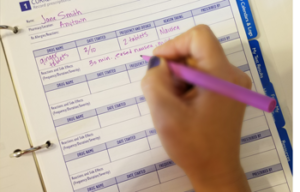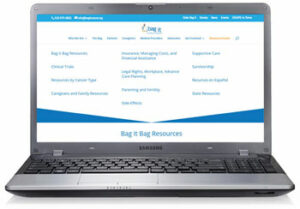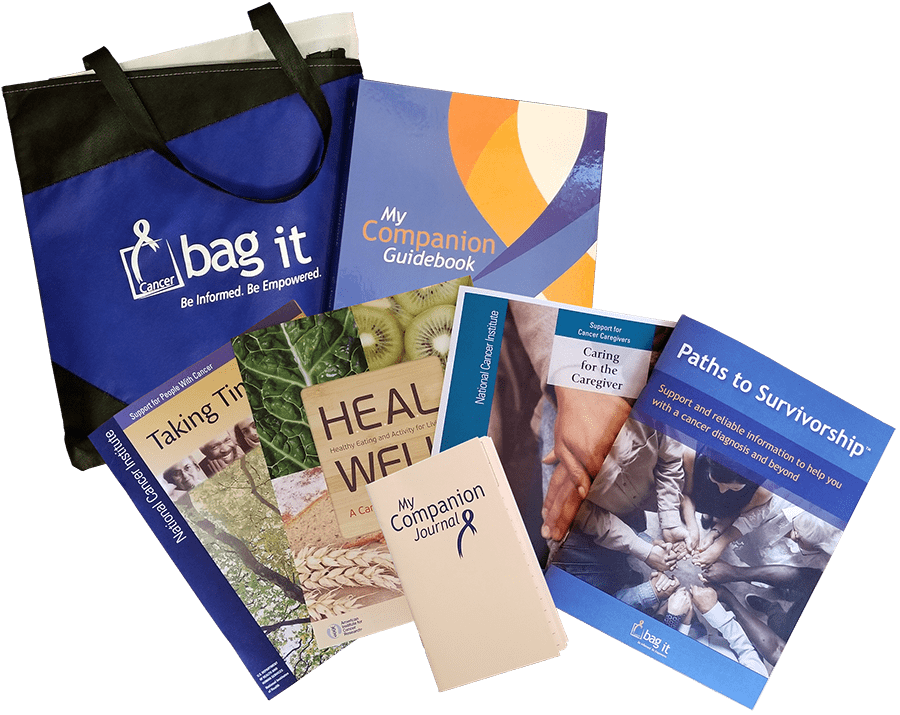By Friend of Bag It
Recently, my older widowed neighbor was diagnosed with cancer. She was shocked by her diagnosis and knew nothing about cancer because “no one in the family had cancer.” I offered to accompany her on her upcoming appointments as another pair of ears and a scribe. This began a journey where I learned, first-hand, how hard it is to manage this diagnosis, and how incredibly important the right tools and the right information can be. I knew how her soon-to-be-received bag could help Mary and her family through this difficult time, and that put a smile on my face. The solid cancer information found in the printed pubs and reliable cancer websites found in the resources section of the binder and Bag It’s website will help them navigate during and after treatment.

On appointment day we had to arrive 30 minutes early for Mary to deal with the sheaf of paperwork that greeted her. Her cancer pain visible on her face, it was a struggle for Mary to fill out her extensive medical history from memory. While Mary had received a full printed list of her meds from her smart PCP, she could not find it in her wallet. As I sat there watching her try to recall all the names and doses of the meds she took, I visualized how much easier and less stressful it would have been for Mary if she could have just copied all of her personal medical information from the pre-filled forms in her Bag It binder onto the provider’s forms.  Ten minutes tops. As it turned out the forms were incomplete when we were called into the exam room 45 minutes later. The MA filled in some of the gaps. The kind doctor confirmed the cancer diagnosis, specifying the location, stage and grade of the tumor. It was described as an “aggressive” cancer, and surgery was necessary. A sentinel node biopsy would determine the extent of the surgery. The need for chemotherapy and/or radiation would be known after the full pathology results were in. The doctor spoke in a straightforward manner that provided the basic facts without much elaboration. Things moved quickly as surgery timing and next steps were discussed. Mary posed one or two questions about post-op home care needs but nothing about her cancer or treatment – she didn’t know what to ask.
Ten minutes tops. As it turned out the forms were incomplete when we were called into the exam room 45 minutes later. The MA filled in some of the gaps. The kind doctor confirmed the cancer diagnosis, specifying the location, stage and grade of the tumor. It was described as an “aggressive” cancer, and surgery was necessary. A sentinel node biopsy would determine the extent of the surgery. The need for chemotherapy and/or radiation would be known after the full pathology results were in. The doctor spoke in a straightforward manner that provided the basic facts without much elaboration. Things moved quickly as surgery timing and next steps were discussed. Mary posed one or two questions about post-op home care needs but nothing about her cancer or treatment – she didn’t know what to ask.
 Since then, I think about all the ways Mary could have benefited from receiving a Bag It bag at the initial time of diagnosis or during this early appointment. From the forms, calendars and glossary of basic cancer terms in the navigation binder to the printed pubs with tips on how to prepare for appointments/questions to ask about diagnosis/treatment, ways for patients and families to cope with their diagnosis, how to be an active member of their health care team, and so much more. The Bag It resource center on the website offers more than 150 reliable sites for patients and their families to find credible information and resources right when they need it. Topics include cancer types, clinical trials, side effects, supportive care/emotional support, caregivers and family resources, insurance, and financial assistance, legal rights, advance care planning, and survivorship. Check it out These advantages also serve the healthcare team as Mary would have the tools and knowledge to be more prepared, organized, and better informed. By using her Bag It bag Mary would ideally take a more active role in advocating for herself and likely improve her quality of life as a result. The early window of opportunity to provide a Bag It bag can easily be missed for a variety of reasons but remember it is helpful at any point in the continuum of care and for any type of cancer.
Since then, I think about all the ways Mary could have benefited from receiving a Bag It bag at the initial time of diagnosis or during this early appointment. From the forms, calendars and glossary of basic cancer terms in the navigation binder to the printed pubs with tips on how to prepare for appointments/questions to ask about diagnosis/treatment, ways for patients and families to cope with their diagnosis, how to be an active member of their health care team, and so much more. The Bag It resource center on the website offers more than 150 reliable sites for patients and their families to find credible information and resources right when they need it. Topics include cancer types, clinical trials, side effects, supportive care/emotional support, caregivers and family resources, insurance, and financial assistance, legal rights, advance care planning, and survivorship. Check it out These advantages also serve the healthcare team as Mary would have the tools and knowledge to be more prepared, organized, and better informed. By using her Bag It bag Mary would ideally take a more active role in advocating for herself and likely improve her quality of life as a result. The early window of opportunity to provide a Bag It bag can easily be missed for a variety of reasons but remember it is helpful at any point in the continuum of care and for any type of cancer.



Recent Comments